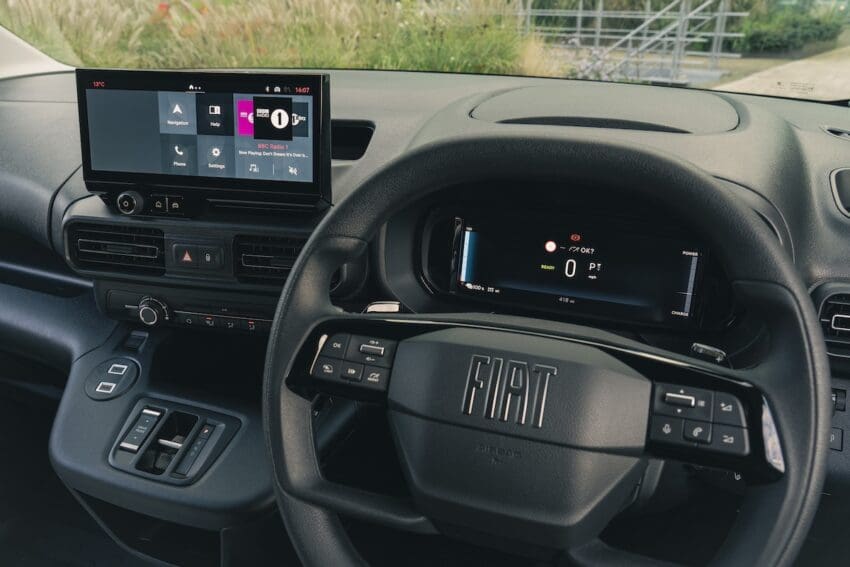Fiat E-Doblo review
We find out if the Fiat E-Doblo can do anything different to stand out in a market packed with capable rivals
The little Fiat E-Doblo is the forgotten sibling in Stellantis’ swathe of brands and models that count for around a third of the UK van market, but it definitely exists and has just received a significant facelift.
Its first problem is that it’s facing up against some serious competition, including the Citroen e-Berlingo, Peugeot e-Partner and Vauxhall Combo Electric. They’re all good vans and, crucially, identical to the Fiat. Then there’s the new-ish Mercedes eCitan and Nissan Townstar, both related to the Renault Kangoo. The Toyota Proace City Electric, with its generous 10-year warranty, adds further rivalry, as do options like the Maxus eDeliver 3 and eDeliver 5.
With such a crowded field, should the E-Doblo capture more attention?
Design, interior, and technology
Externally, the E-Doblo combines a retro look, harking back to Fiats of old, while also looking fresh and modern. That’s a good trick to pull off, especially as the basis of the van dates back to 2018. It doesn’t look as contemporary as the Vauxhall Combo Electric, though, with its black razor grille and can’t quite pull off modern-retro as well as its Citroen sibling.
Inside, updates are rather sparse. A new 10-inch infotainment screen is available in some models, though the rest of the cab layout remains essentially unchanged, save for a slightly altered steering wheel. That means it’s fine, with little to complain about but even less to get excited about.

Two trim levels are on offer: Doblo and Primo. The Doblo trim (is it even a trim if there’s no trim name?) includes essentials like air conditioning, cruise control, and basic safety features but omits a built-in infotainment screen. Instead, it features a smartphone station to hold your phone firmly in place, allowing you to use that as your audio system and navigation tool and, with a Fiat app, control some elements of the van.
The Primo trim adds a 10-inch touchscreen with satellite navigation, a digital instrument cluster, LED headlights and Dynamic Surround View — this offers camera views around the van for added safety during parking and lane changes, displayed on a digital rearview mirror.
In Primo models, a two-person passenger bench with secure storage underneath is fitted, while plain Doblo users make do with a single passenger seat. However, that makes for a slightly roomier cabin, especially since there’s no gearbox housing to contend with in the electric model.
Battery, motor, and performance
The Fiat E-Doblo has a 50kWh battery, giving it a solid 205-mile range (WLTP), which outpaces the Kangoo’s 176-mile capability. Charging has been enhanced with 100kW rapid charge support, halving previous times and enabling a 0-80% charge in 30 minutes. A 7kW onboard charger also allows overnight home charging in under eight hours.
Drivers can select from Eco, Normal, and Power modes to balance performance and efficiency. In Eco, power is capped at 80bhp to maximise range, though it still performs well for urban use. The full 134bhp is available in Power mode, ideal for highway driving, with Normal mode striking a middle ground.
The E-Doblo’s chassis, shared with models like the Peugeot 308, delivers a smooth, comfortable ride, although it doesn’t quite match the handling sharpness of the eCitan.
Payload and practicality
The Fiat E-Doblo comes in two sizes: a standard 4.4-meter L1 model and the 4.75-meter L2 version, which increases load volume by 20%, from 3.3m³ to 3.9m³, which is right there with the best in class.
There’s also a class-leading payload capacity of 781kg, which outperforms every competitor except for the larger Maxus eDeliver 3. Towing limits are low, at just 750kg.
Standard models include a single sliding side-loading door and double rear doors, while the XL version adds a second side-loading door.

Fiat E-Doblo price and specification
Starting at £27,955 (excluding fees and VAT), the E-Doblo matches its Stellantis siblings pound for pound, and all qualify for the government’s £2,500 plug-in van grant. The uplift to take the more comfortable Primo trim is £2,100, which sounds a lot for an infotainment screen, a flash camera-based rearview mirror and some LED headlights (amongst other bits of kit), but it’s probably a worthwhile investment if you’ll be spending a lot of time in the van. You’re likely to get most of it back at resale, too.
All models come with a three-year, 100,000-mile warranty, with an eight-year warranty on the battery, which aligns with Stellantis standards. However, the all-but-identical Toyota Proace City Electric offers an attractive 10-year warranty, although it costs a little more at £30,578.
Verdict
The compact electric van market is undoubtedly crowded, especially with five nearly identical models across the Stellantis range, if you include Toyota. That makes it difficult for the Fiat E-Doblo to stand out, as there’s nothing in its armoury to rise above its related rivals.
It’s a well-rounded option, with solid equipment levels, good comfort, and impressive payload capacity, but nothing to make you put your money down — as Fiat is finding out.

Fiat E-Doblo L2 Primo Panel Van
- Price: £31,005 plus VAT and OTR
- Powertrain: front-motor, front-wheel-drive
- Battery: 50kWh
- Power: 134bhp
- Torque: 119lb ft
- Top speed: 82mph
- 0-62mph: 11.7s
- Range: 205 miles
- Consumption: 4.1m/kWh
- Charging: up to 100kW






